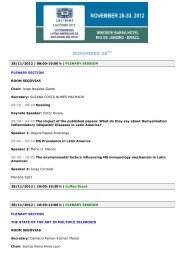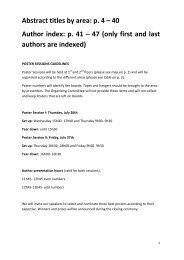Keynote Conference - Interevent
Keynote Conference - Interevent
Keynote Conference - Interevent
You also want an ePaper? Increase the reach of your titles
YUMPU automatically turns print PDFs into web optimized ePapers that Google loves.
Symp#9 Immune Cell Biology<br />
Chair Wilson Savino<br />
Wilson Savino<br />
Instituto Oswaldo Cruz, FIOCRUZ, Rio de Janeiro, Brazil<br />
Introductory notes and talk<br />
Immunological and Clinical Outcomes of a New DC-Based Vaccine<br />
Flavio Salazar-Onfray and Mercedes López<br />
1 Millennium Nucleus on Immunology and Immunotherapy, Faculty of Medicine, University of Chile.<br />
We developed an original method for production of therapeutic dendritic-like cells named Tumor Antigen Presenting<br />
Cells (TAPCells ® ) using an allogeneic melanoma-derived cell lysate (TRIMEL) as activation factor and antigen provider.<br />
TAPCells-based immunotherapy induced T cell-mediated immune responses and improved long-term survival of stage<br />
IV patients in studies involving more than 100 individuals (López et al. 2009, J Clin Oncol; Aguilera et al. 2011, Clin<br />
Cancer Res). Importantly, 61% of tested patients (58 out of 94) showed a Delayed Type Hypersensitivity (DTH) reaction<br />
against TRIMEL indicating the development of anti-tumor immunological memory that correlates with prolonged<br />
patient survival. The in vitro analysis of TRIMEL showed that it contains damage associated molecular patterns such as<br />
HMBG-1 protein, induced by heat shock, capable to improve, through TLR4, the DC maturation and antigen crosspresentation.<br />
In fact, a TLR4 polymorphism correlates with patient clinical outcome. DTH response against TRIMEL was<br />
associated with prolonged survival of the stage IV responder melanoma patients (DTH +; 35 months) compared to the<br />
non-responders (DTH -; 11 months). Furthermore, we observed that DC-vaccination resulted in a three-fold augment<br />
of Th1 cell population releasing IFN-γ and a two-fold increase of Th17 lymphocyte population capable to produce IL-17<br />
in the PBL of DTH+ patients respect to DTH- ones. Antibodies against melanoma antigens can be detected in the sera<br />
from several vaccinated patients, althougth no correlation with clinical responses could be established. Taken<br />
together, our results indicate that TAPCells immunization resulted in two different pattern of response associated to<br />
the immunological and clinical outcome. Our study may contribute to the better understanding of clinical<br />
immunological responses produced by DC-vaccines and to the development of improved DC-based vaccines.<br />
Supported by Fondecyt 1090238 and 1090243.<br />
Eph/ephrin-mediated Interactions Govern Functional Maturation of Developing Thymocytes in the Thymic Epitelial<br />
3D Network<br />
Agustín G Zapata 1 , Juan J Muñoz 2 , David Alfaro 1 , Javier Gª Ceca 1 , Teresa Cejalvo 2 , Esther Trobajas 1 , Sara Montero 1<br />
(1) Department of Cell Biology, Faculty of Biology, (2) Centre for Cytometry and Fluorescence Microscopy,<br />
Complutense University, 28040 Madrid, Spain<br />
The thymus is a primary lymphoid organ in which a 3D epithelial network supports the functional maturation of<br />
lymphoid progenitors into T lymphocytes. The process is highly dependent on the migration of developing thymocytes<br />
to the adequate thymic niche in which thymic epithelial cell (TEC)-thymocyte interactions are critical. In the current<br />
presentation we report the role played in these processes by Eph and ephrins, a large family of receptors and ligands,<br />
respectively involved in the organogenenesis and homeostasis of numerous tisssues, regulating cellular<br />
attachment/detachment. They are extensively expressed in the thymus, partially govern colonization of lymphoid<br />
progenitors and their migration throughout thymic parenchyma and their lack deeply affects not only T-cell maturation<br />
but also correct organization of thymic epithelial network, reflecting the relevance of these molecules in the<br />
thymocyte-TEC interactions that largely modulate the biology of thymus<br />
61





